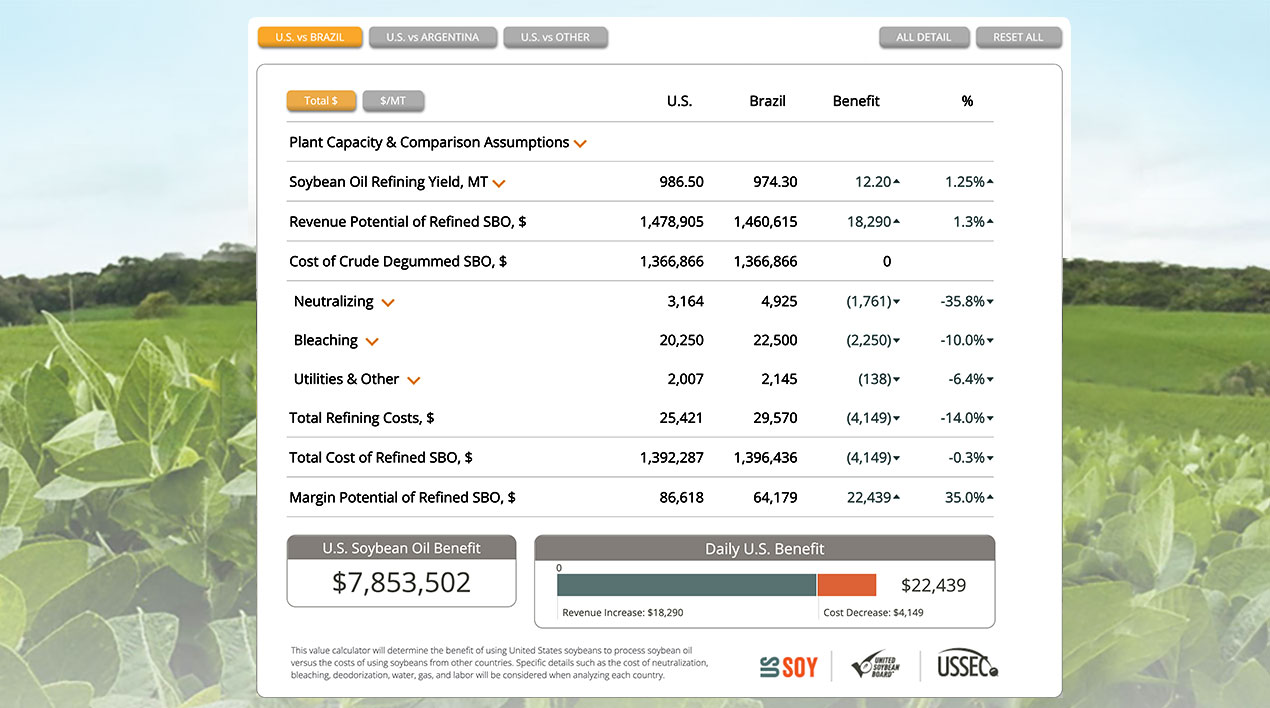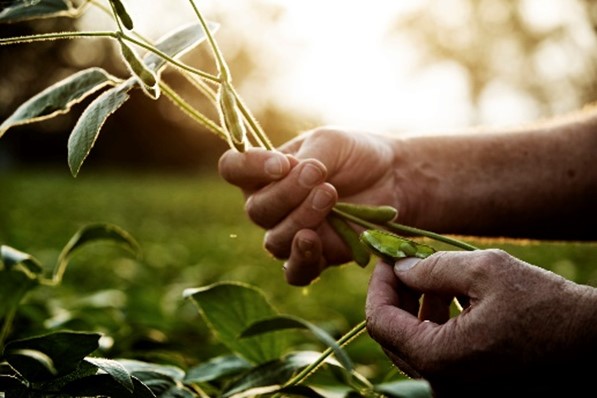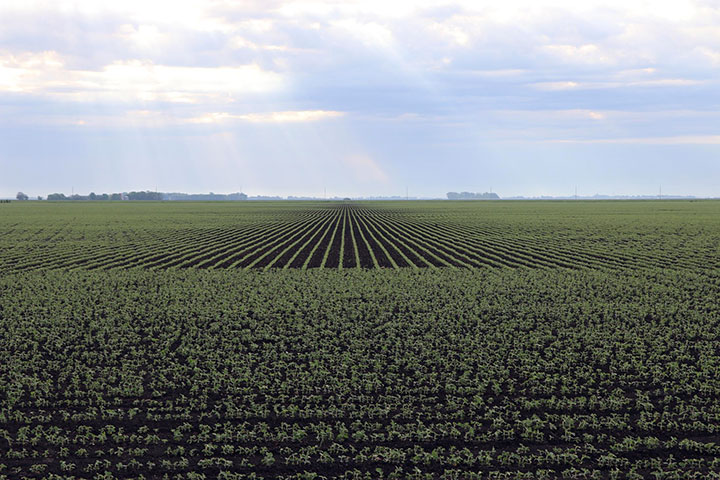

U.S. Soy
Delivers
Solutions
For you.
For your customers.
For the planet.
Delivering transparent tools to help you discover the greatest value.
Our commitments are demonstrated by our suite of cutting-edge technologies, tools and services. Examples include the Soybean Value Calculator, Nutrient Value Calculator, Oil Value Calculator, U.S. Soy Sustainability Assurance Protocol, Specialty U.S. Soy Database, our work to develop more efficient In-Pond Raceway Systems for aquaculture, and many more. These tools directly support customers, helping them to evaluate and determine true economic value, better understand crucial differences between U.S. Soy and soy from other origins, and identify appropriate technologies for R&D, production, marketing, and customer needs.
U.S. Soy Solutions
We are driven by the industry’s relentless focus on innovation, transparency, value, consistent improvement and reliability. We do this to earn your trust and confidence and help you deliver with your customers across the globe.
With the data, tools and services that U.S. Soy provides, you can feel confident that your investment in U.S. Soy will enable superior economic value and sustainability. Learn more about our innovative tools below.
Soybean Value Calculator
The Soybean Value Calculator is an innovative tool that enables soybean crushers to calculate and compare the economic value of crushing soybeans from different origins. Customers should enter data specific to their facility or experience, along with composition and physical factor data of whole soybeans, to analyze the estimated total benefit of U.S. Soy relative to other origins.
Soy Oil Value Calculator
The Soy Oil Value Calculator is a global tech tool that enables crushers and refiners to make better decisions in their soybean and soybean oil purchases based on the refining differences of the origin of the oil. The tool looks at the rate of refining, and the variable cost of refining for soybean oil from the U.S., Brazil and Argentina, and is based on almost 500 samples of crude degummed soybean oil collected in real-world conditions. The tool can show — in real-time — the economic advantages of choosing a particular soy oil.
The calculator analyzes soybean oil refining yield, revenue potential of refined soybean oil, cost of crude degummed soybean oil, and refining costs (neutralizing, bleaching, utilities).
To better inform your investments, contact your local USSEC representative and schedule a demonstration today.

U.S. Soy Sustainability Assurance Protocol (SSAP)
Get a U.S. Soy Sustainability Assurance Protocol (SSAP) transferable certificate to address your customer requests for documented and verified sustainable soy. The SSAP verifies that soybeans and soy products produced in the United States are compliant with a system of sustainability and conservation laws and regulations and farmer participation in the U.S. Farm Program. SSAP is one of the largest sustainability verification programs in the agriculture industry and has proven to be a highly reliable measure of U.S. Soy farmers’ commitment in areas like biodiversity, sustainable production practices, public and labor health, and continuous improvement of farming practices.
Click here for an U.S. Soy Sustainability Assurance Protocol certificate

U.S. Soy Crop Quality Report 2023
How did U.S. Soy quality measure up in 2023? Despite weather conditions, U.S. Soy farmers delivered a high quality, and sustainably produced crop. Explore the U.S. Soy Crop Quality Report 2023 including a look at amino acid profiles and soluble sugars.
Summary:
- A severe and chronic drought affected soybean production across most of the major U.S. soybean producing States in 2023.
- Despite exceedingly challenging production environments, U.S. Soy farmers are estimated to produce a crop averaging 3.3 MT per ha. (~50 bushels per acre).
- Average composition of the crop is very similar to 2022.
- One could consider this an ‘Oil Year.’
- Weather conditions resulted in beans being drier than usual, leading to increased protein and oil yields per ton.

In-Pond Raceway Systems (IPRS) Manual
The In-Pond Raceway System (IPRS) aquaculture technology helps aquaculture producers to increase fish production while significantly reducing environmental impact and optimizing operating cost. This IPRS Manual provides both readers and developers with answers to these questions and more: What is it? Who should use it? What are its advantages?

Aquaculture: 20 Technical Bulletins To Dive Into
Did you know that soybean meal is the most used protein source in aquaculture feeds worldwide? These 20 aquaculture technical bulletins cover a range of topics from genetic concepts for selective breeding to disease management, and from storage and handling of feed to responsible governance – to help set businesses up for success.

International Aquaculture Feed Formulation Database (IAFFD)
The International Aquaculture Feed Formulation Database (IAFFD) is an open access, free of charge, database that provides a potentially valuable tool to the aquaculture industry to customize feed blends to improve production for optimal nutrient value.

Specialty U.S. Soy Database
The Specialty U.S. Soy Database is an online tool that enables food companies and food-grade soybean buyers to choose U.S. Soy varieties by intended use in soy foods (for example, tofu, miso, soy milk, soy sauce, and others), plus protein level, quality, composition, and genetic characteristics. It is the single largest source of information on the quality of more than 125 U.S. soybean varieties for use in soy foods.

High Oleic Soybean Oil Sourcing Guide
The High Oleic Soybean Oil Sourcing Guide is an informative resource for international customers seeking high stability oils and provides added value amid current oil market volatility. The sourcing guide provides comprehensive background information needed for global market customers to facilitate the sourcing of U.S. high oleic soybean oil, which can be used across a variety of food production sectors. It is available in six languages: Chinese Simplified, Chinese Traditional, English, Japanese, Korean and Spanish.

Sustainable U.S. Soy Label
The Sustainable U.S. Soy label is now on 850+ product packs forming an important part of the participating companies’ commitments to advancing the U.N. Sustainable Development Goals. U.S. Soy has the lowest carbon footprint compared with soy of other origins, with U.S. Soy farmers fully committed to advancing U.N. Sustainable Development Goal 2 – Zero Hunger.

